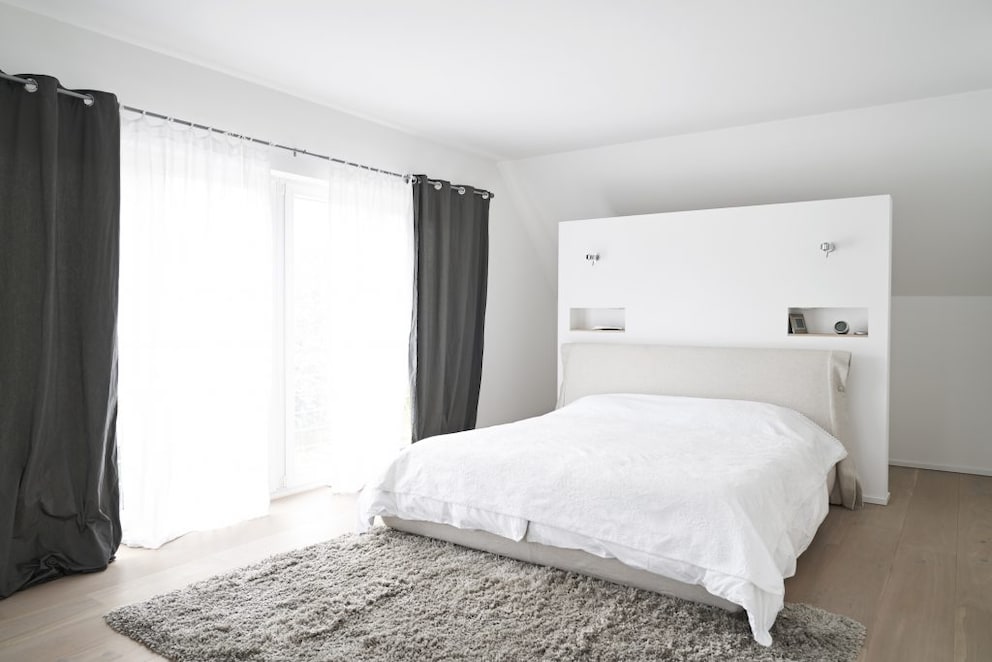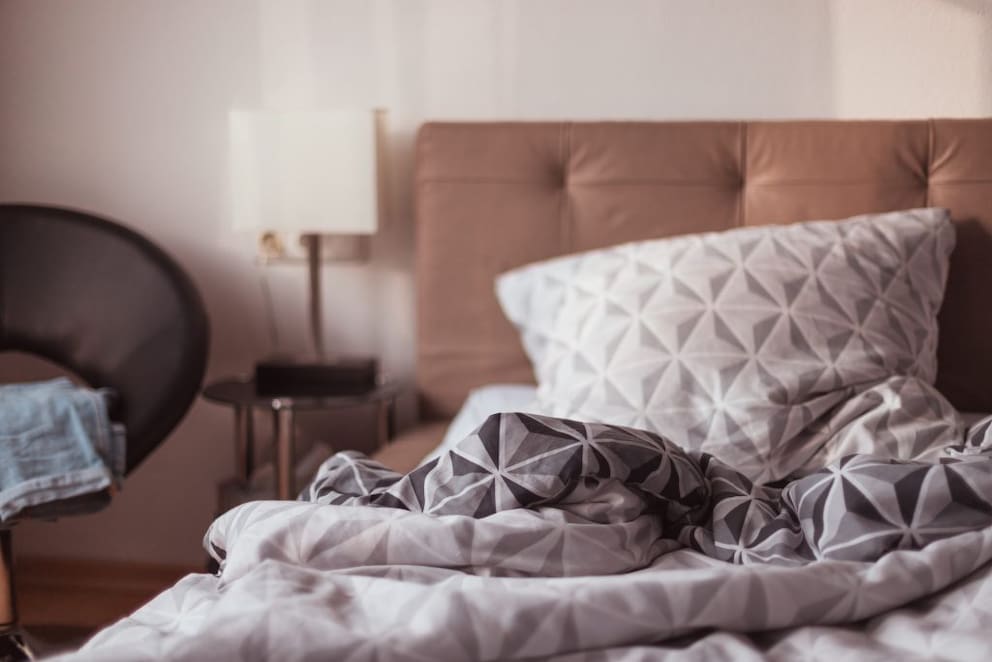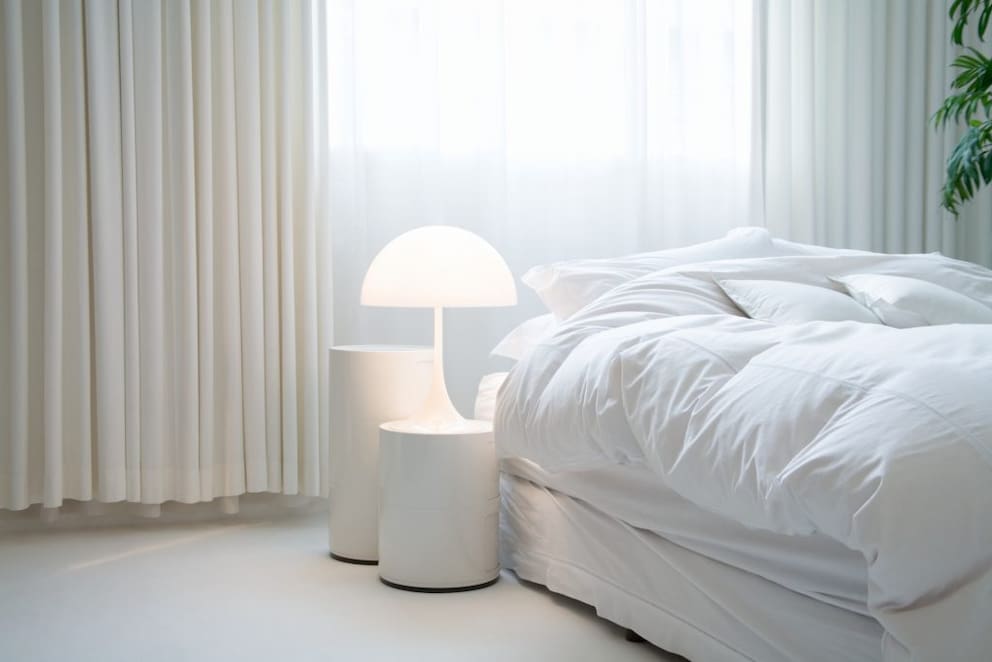May 26, 2021, 10:33 am | Read time: 6 minutes
Insomnia isn’t always due to stress—it can also be caused by the wrong setup in the bedroom. Furniture, lighting, bed placement—all of these need careful consideration. Otherwise, your nighttime comfort might suffer. An interior designer reveals six common bedroom mistakes and how to avoid them.
We spend several hours each day in the bedroom. Even though our eyes are closed most of the time, there are some disruptive factors that make falling asleep difficult. For instance, if the bedroom is too sparsely furnished, it can lack a cozy atmosphere. However, you should also avoid overcrowding the room with bulky furniture and accessories. Learn about common mistakes in bedroom design and how to do it right here.
Overview
1. Mistake: Misaligning the Bed
Start arranging your bedroom by positioning the bed and aligning all other furniture accordingly. While it may look unique, never place a bed in the center of the room. It will make you feel restless. A bed against the wall, on the other hand, provides a sense of security and comfort.
Alternatively, you can use a room divider, which gives the subconscious the impression of a solid wall. Ideally, the headboard should be against a wall, with the feet free in the room. If you follow Feng Shui principles, ensure the bed is not near heating or water pipes, nor above a water vein.

The optimal energy flow is also disrupted if the bed is directly between a window and a door, or worse, if the foot of the bed faces the door. Generally, keep the foot of the bed clear. Never place a wardrobe at the end of your bed, as it creates a cramped feeling.
When choosing the right mattress, don’t rush the decision. Ideally, get advice from a specialist store and try it out. After purchase, let the new mattress air out for 72 hours to dissipate most chemical odors. Avoid too many artificial or metallic materials. Bed providers often promote box spring beds, but these are rich in metal reinforcements inside.
Related: 7 Tips to Enlarge a Small Bedroom
2. Mistake: Bulky Furniture in the Bedroom
In general, don’t overload your bedroom with too many large pieces of furniture! Even though clothes for more than one season and various bedding need storage, there are other storage options. Bulky furniture visually narrows the room and affects the subconscious during sleep. As a rule of thumb, calculate about 7.5 square meters of space per person. This ensures enough oxygen and prevents the room from feeling oppressive.

For decades, entire wardrobe walls dominated bedrooms, creating an overwhelming effect. They significantly narrow the room and block light. Increasingly, standalone furniture like dressers, wardrobes, and shelves are found in bedrooms. These are also much more moving-friendly.
If your bedroom has limited space, choose models with sliding doors. Furniture with integrated mirror functions also helps, as they make the room appear larger and save you an extra piece of furniture. If there’s not enough space for a wardrobe, clothes racks or combined shelving solutions are currently popular.
Also interesting: 9 Plants Perfect for the Bedroom
3. Mistake: Too Many Accessories in the Bedroom
Don’t get lost in too much kitsch with accessories, as it makes the room feel “closed in.” Less is definitely more in this case. The bedroom should be set up in a purist and clear manner. However, it shouldn’t lack coziness, which can be achieved through textiles like curtains on windows, runners in front, and pillows on the bed.

Textiles act as additional heat storage in the room, and carpets provide a pleasant step when getting up. A bedspread also quickly creates visual order. Otherwise, focus more on function with accessories. Boxes and crates that slide under the bed can provide more storage for clothes and bedding, potentially saving you another piece of furniture.
4. Mistake: The Wrong Colors in the Bedroom
Color in the bedroom doesn’t just mean the wall color but also the rest of the room. The concept should be harmonious and balanced, ideally tending towards a monochrome color scheme. This means everything stays more or less in one tone, bringing calm and balance. If that’s too monotonous, you can break up the color scheme with soft contrasts. How about a light gray tone for walls and furniture? Avoid extreme contrasts with yellow, red, or blue. A subdued color scheme with muted but bright, friendly shades gives the room a sense of peace and security.
Regarding wall color, it’s important to choose a breathable paint. Mineral paints (also called silicate paints) are best, as they have a special diffusion capability. The paint allows water vapor to pass through, preventing condensation and allowing the substrate to breathe. This is especially beneficial for allergy sufferers, as no dirt particles or bacteria can accumulate. Mineral paints would also be an optimal choice for the children’s room. Generally, the fewer colors, wallpapers, or other wall treatments, the better, as these often bring a host of chemicals and emissions.
Also interesting: How to Combine the Trend Color Coral
5. Mistake: No Warm Lighting

Lighting also significantly contributes to comfort in the bedroom. Since larger furniture often absorbs a lot of light, optimal general lighting is needed. The ceiling light should have a shade that allows for broad light distribution in the room. Solve the rest of the lighting concept with smaller light sources like bedside, wall, or individual delicate pendant lights. For a pleasant atmosphere, pay attention to the exact light color when purchasing the light bulb. A value between 2700 and 3300 Kelvin is optimal for warm white light.

7 Tips to Make a Small Bedroom Feel Larger

Scandinavian Bedroom Design: 6 Tips for Nordic Coziness

6 Things You Should Ban from Your Bedroom Now
6. Mistake: Using Smartphones in the Bedroom
Modern technical devices like smartphones, tablets, or flat-screen TVs are now standard equipment in many households. Many of these products have even made their way into the bedroom. But that’s a mistake, as modern technology can significantly disrupt sleep. It’s proven that the blue light from smartphones, tablets, laptops, and flat screens makes it harder to fall asleep. Blue light is also a major component of normal daylight, known to make us alert and influence our moods and reaction times.
In LED light, the blue light content is even higher, so smartphones or tablets simulate a daytime situation in the bedroom. The result: the brain stays awake, and we have trouble sleeping. Maybe it’s time for a good book or an exciting audio play again.

